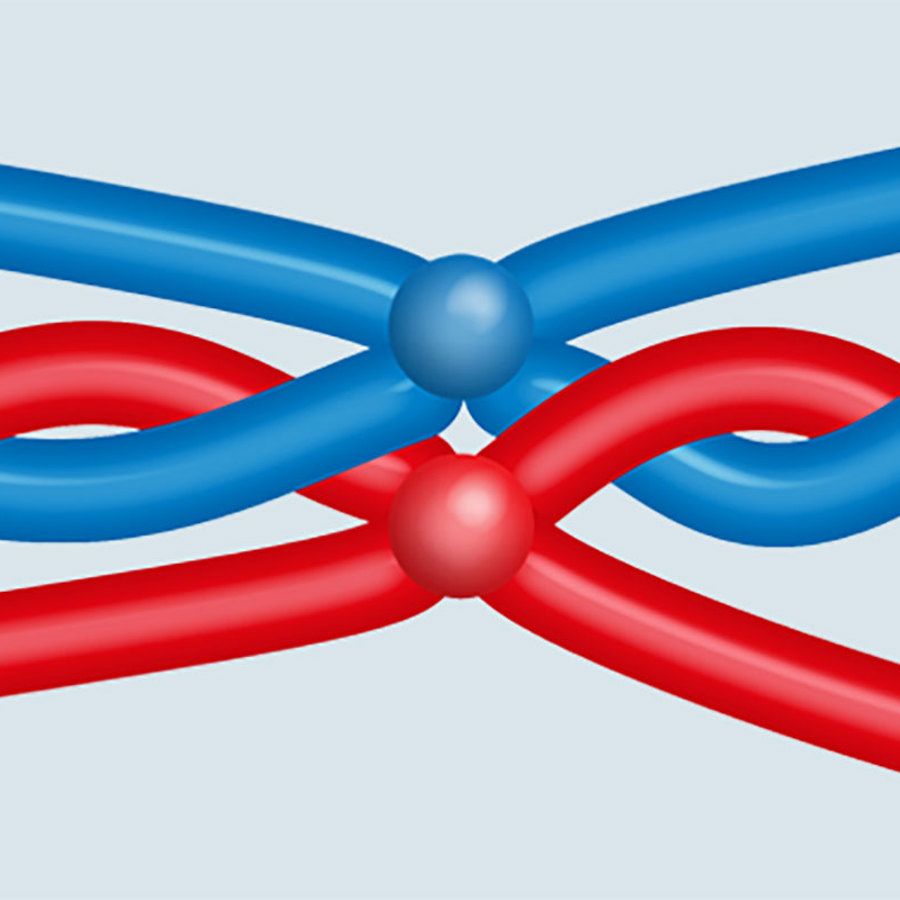
Does crossing-over ever occur within a gene?
June 16, 2015

- Related Topics:
- Recombination,
- Meiosis,
- Chromosomes
A graduate student from Arizona asks:
“I know that crossing over can happen along chromosomes, but can crossing over happen inside genes themselves? It seems from what I have read that it can’t.”
The quick answer is that yes, it can. And it is one of the ways that the seemingly impossible in genetics does sometimes happen.
Let’s use hair color as an example. You may remember the Weasleys from Harry Potter. Both parents and all their kids had red hair which makes perfect sense genetically. Since red hair is usually a recessive trait, two red-haired parents will almost always have red-haired children.
Now imagine they have another child but he doesn’t have red hair. Seems impossible, right?
Well, one way they might have a child without red hair is through crossing over within the gene responsible for red hair. Even though we learned in school that two redheads could only have kids with red hair…
Two Parents, Two Gene Copies
DNA is the genetic information that gives your body the instructions to make you. You are unique because you have unique DNA (and unique experiences).
Genes are an important part of your DNA. A gene is a stretch of DNA with the instructions for one small part of you.
There are genes that let you tell red from green, others that might keep you from having brown eyes and one that decides whether or not you’ll have red hair. Of course this list is incomplete — your DNA (and everyone else’s) has tens of thousands of genes!
DNA is wound up really tightly and packaged in long stretches called chromosomes. You can think of these like instruction books.
Most people have 46 chromosomes that are arranged in 23 pairs. They’re arranged in pairs because most people will get one from each pair from their mother and one from their father.
Here is what this might look like for one of the 23 pairs:
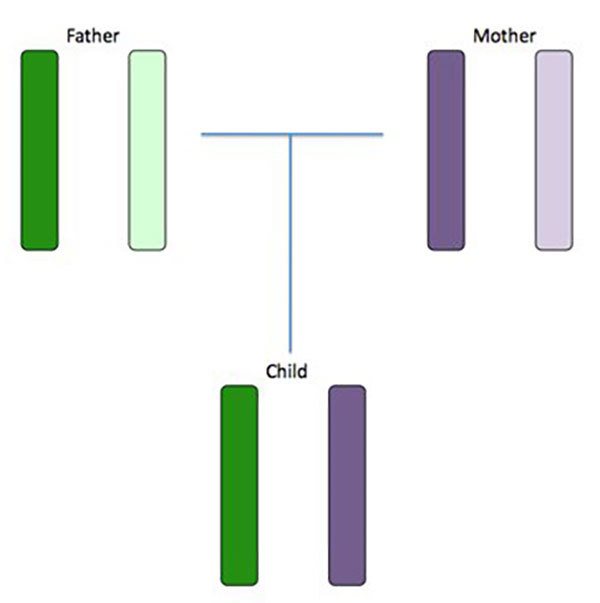
In this picture each chromosome is a rectangle. The child would have gotten one chromosome from their father (the dark green) and one from their mother (the dark purple).
This is just one of four combinations, though. The child could have gotten the light green from their father and/or the light purple from their mother. The chances of any combination are equal.
But things aren’t that simple! Chromosomes are almost never passed down whole like in this picture. Instead, before we pass them on to our children the chromosomes swap DNA with each other. This is called crossing over (or recombination).
In reality, this is probably what we are more likely to see:
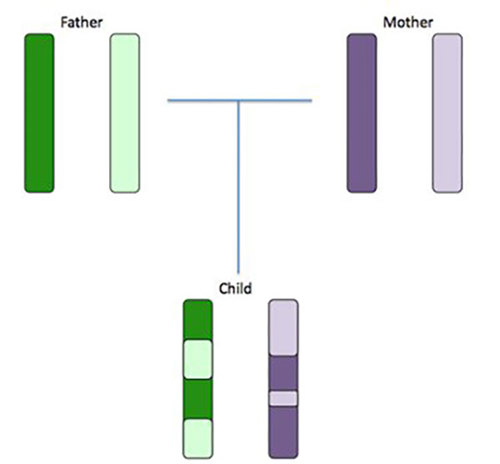
Keep in mind, though, this is just one of the many possible combinations of light and dark green and purple. Crossing over can happen at any place in a chromosome leading to infinite color combinations! It can even happen within genes.
Crossing over is really common too. It happens every time a sperm or egg is made.
Crossing Over Within Genes
As I said, we have two copies of each of our chromosomes (except males, who have an X and a Y for their 23rd pair). What this also means is that we each have two copies of most of our genes too. One comes from each parent.
DNA swapping can happen between the maternal and paternal gene copies. Usually this isn’t a big deal but sometimes it can lead to some very interesting results.
Let’s bring back the Weasleys as an example to show how the supposedly impossible can become possible because of crossing over. Remember, the Weasleys are a family from Harry Potter where everyone, parents, and children, have red hair.
There is a gene called MC1R that is the key player in giving people red hair. There are many versions (or alleles) of this gene, but they fall into two main categories. One type can cause red hair, which we will call red. The other type prevents red hair, which we will call not-red.
Let’s say the alleles look like this:
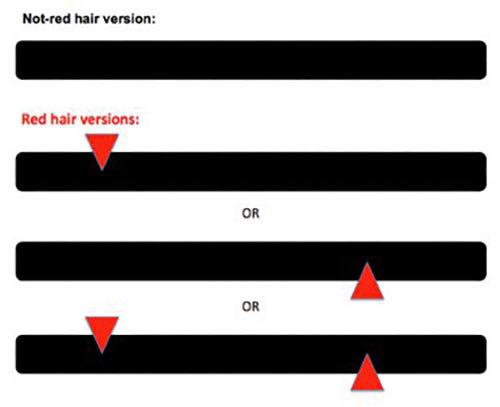
Now of course a real gene is a long stretch of A’s, G’s, C’s, and T’s. To make things simpler, we are representing the gene as a black rectangle. Changes in the letters of the gene that turn the not-red version into the red version are shown with red triangles.
These changes are really small differences in the DNA (often referred to as SNPs). A G changed to a C or some other little change.
The first red version here has a triangle (or DNA difference) at the left end of the gene and the second version has one at the right end. The third version has two triangles, one at each end.
But like I said, people have two copies of this gene. In order to have red hair, you usually need to have two “red hair versions” of the gene (this is why red hair is recessive). If someone had at least one “not-red hair” copy, they usually don’t have red hair.
So for this example, we know Arthur and Molly Weasley have red hair, so let’s say this is what their two copies look like:

Now, whenever Arthur and Molly go on to have children, they pass on one copy of each gene. For instance, let’s show what would happen when they pass their genes to Ron. That might look like this:
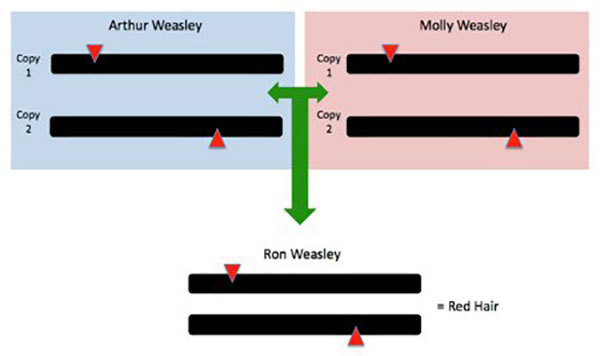
Which copy they pass on is completely up to chance! But, you can see that no matter which copy they passed on, Ron would have red hair. He will always get a red hair version for each of them.
But what if they had another child and that child had black hair? How do we explain that genetically?
They might have a child with black hair because of crossing over. Crossing over is when the two gene versions get mixed up to form new, different versions. Let’s say that this crossing over happened in Molly Weasley. That might look like this:
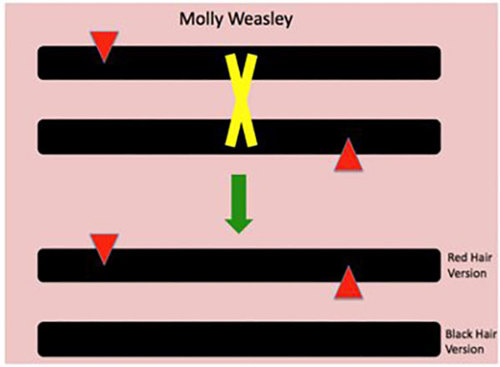
Remember that this crossing over happened in one egg cell of Molly Weasley, so it doesn’t affect her hair color. However, when Molly is passing her genes on to the next child, let’s call him Bob, there’s a chance for Bob to get the not-red-hair version like this:
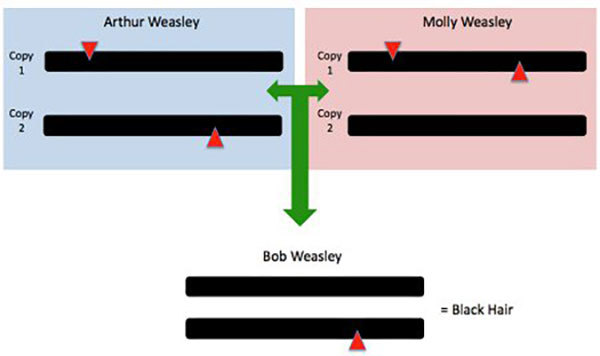
Now as you can see, Bob has a not-red version and a red version. He does not have red hair (and happened to end up with black hair). It is possible through crossing over for the Weasleys to have a black-haired child.
So, crossing over can happen within genes themselves. This can even lead to different traits than you would expect in children.

Author: R.J. Okamura
When this answer was published in 2015, R.J. was a student in the Stanford MS Program in Human Genetics and Genetic Counseling. R.J. wrote this answer while participating in the Stanford at The Tech program.
 Skip Navigation
Skip Navigation
